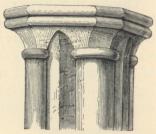The following description is lifted directly from [Blight 1885] but note that the text was prepared for the Gentleman’s Magazine 1862-64 and is largely unaltered. It must be read in the context of that date. The drawings are by the author.
The church of ST. SENNEN, or Senanus, an Irish abbot who accompanied St. Burian into Cornwall, is four miles from St. Levan, and rather more than that distance from St. Burian. It is a small, low structure, standing on high ground about a mile from the Land’s End, and exposed to all the storms of the Atlantic. The plan of this church is nearly the same as that of St. Levan; here, however, the chancel projects beyond the aisle, which is not the case at St. Levan. The aisle has three arched windows on the south side, and one at either end. The chancel window has a round head. A square-headed window with a hood-moulding, on the south side of the chancel, is blocked up. The transept has two windows, one square-headed, the other arched. The flat-headed north doorway is also walled up. The stone mullions and tracery of all the windows have been removed, and their places occupied by ugly wooden frames. The belfry-lights alone remain in their original condition. Internally the church is in a most dilapidated condition, and, like its neighbour, has been plentifully bedaubed with lime-wash.

Capital, St. Sennen.
An arcade of six arches connects the nave and aisle. The piers are shafted at the angles, the capitals consisting simply of round and cavetto mouldings. The transept is connected with the nave by a single four-centred arch.
The roodscreen has been entirely destroyed. The font has a modern appearance, but stands on an ancient base, which has an inscription in Old English letters. Hals, who visited the church in 1700, writes—
“The Sexton shewed me an inscription on the foot of the font-stone, which he told me several hishops of Exeter and their priests, in their triennial visitations at Buryan and this church, had viewed and inspected, but could not read it. Whereupon, in like manner, I observed on the font-stone the said inscription in a barbarous strange character of letters, of which I could see but part, by reason of a new pew or seat which was built on a part of it however, I interpreted that which I saw to consist of these letters,—Anno Dom. mille. CCCC XX. or XL. in the year of our Lord 1420 or 1440. Let the curious remove the seat and explain the rest; probably the church was then erected.”
The stone has been removed to its present position since Hals saw it, and is not now hidden by any pew. The inscription is of the fifteenth century, in the letters and with the usual abbreviations of the period. A portion of it has been broken away; the remainder appears to be as follows:— “Eccl˜a i˜ decol˜e S. I. B. dedica fvit anno dni millo CCCCXLI.:“ [the tildæ should be above the letters to their left] in full, “[Hæc] Ecclesia in decollatione Sancti Johannis Baptistæ dedicata fuit, Anno Domini Millesimo quadringentesimo quadragesimo primo,” (secundo, tertio, or quarto, as the case may have been; for a portion of the date has evidently been broken away with the missing fragment); and in English, “This church was dedicated on the festival of the beheading of St. John the Baptist, AD. 1441-4.” Hals also tells us that the sexton shewed him “the headless bodies of some images of human shape cut in alabaster that were not long before found hid in the walls of the same, all curiously wrought, which also had been painted with gold, vermilion, and blue bice, on several parts of their garments.”

Mutilated Image of
the Blessed Virgin,
St. Sennen.
One of these images still remains, standing on a bracket which projects from the north wall of the transept. It is 3 ft. 2 in. high. Repeated coats of lime have entirely covered all “gold, vermilion, and blue bice.” And the figure has received rough usage; the head and arms are gone. It was probably mutilated by the Puritans, perhaps by Shrubsall himself, fresh from the demolition of the sanctuary. This image represents a female saint, most probably the Blessed Virgin.
The tower has two bells: one lies on the belfry-floor; it was cast by Thomas Bayley of Bridgewater, in the year 1762: the other bell was cast in 1810.
[The book continues with Madron. The following sketches occur later in the book.]

Impost, St. Sennen. |

St. Sennen Church. |

Section of Pier, |